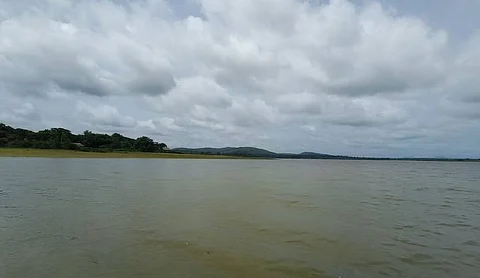

#Ajayan
Kochi |As Bengaluru's thirst for water deepens, Kerala emerges as a potential saviour in this narrative. The heartbeat of Karnataka's capital city, the Cauvery River, draws its life force from the rivers that cascade down from the hills of Wayanad in Kerala through its main tributary the Kabani river. Bengaluru's daily water consumption, which is around 1,450 million litres per day (MLD) from the Cauvery river and an additional 650 MLD from borewells, is currently facing a significant shortage of over 500 MLD.
A network of smaller rivers converges to form the Kabani, which eventually merges with the Cauvery, providing a crucial water source for Bengaluru. The Kabani's journey begins in the Vythiri-Lakkidi hills in Kerala, where it springs forth as the Vythiripuzha and Panamarampuzha rivers. The Mananthavadypuzha, originating in Kunjam, adds to its flow, uniting with the Panamarampuzha at Koodalkadavu in Wayanad passing through the 950-acre protected river delta of Kuruva islands. From there, the Kabani meanders towards Karnataka, passing through Baveli, as a lifeline for the thirsty landscapes it traverses.
From the Tirunelli hills, a trio of rivers—Kalindi, Begur and Baveli—descend to merge with the Kabani, adding to its strength before it continues its journey towards Karnataka. Another tributary, Noolpuzha, begins its tale in Pandalloor, Tamil Nadu, winding its way through the lush forests of Wayanad before joining the Rampur range in the same region. Together, Noolpuzha and Kabani flow eastwards, eventually reaching the Beechinahalli Dam, a vital reservoir constructed on the confluence of the Cauvery and Kabani rivers in Mysuru in Karnataka.
Thus, securing a plentiful flow of water into the Kabani and the fellow tributaries of the Cauvery holds the key to ensuring water availability for both Karnataka and Tamil Nadu. Achieving this goal necessitates a tripartite exercise, facilitated by the Union Government. This will also help address the intricate water-sharing dynamics and ensure equitable distribution among the States involved.
The water crisis gripping Bengaluru finds its roots in uncontrolled development, exacerbated by the impacts of climate change. Insufficient planning and inadequate project execution have compounded the issue. The surge in apartment complexes and commercial structures, driven by urbanization and population growth, stands out as a significant contributor to the current water woes, John Peter, president of People for Forest and Wildlife Conservation Karnataka (PFWCK), told Metro Vaartha. The construction of these complexes also involves extensive digging of the earth to accommodate multiple levels of underground parking, further straining the city's already burdened water resources.
Numerous lakes, once crucial for recharging Bengaluru's groundwater, have been sacrificed for the sake of construction. The proliferation of borewells, both legal and illegal, continues to deplete the groundwater reserves. Even the trees that once graced the city, meticulously planned and developed by Kempe Gowda, the visionary governor during the Vijayanagar Empire in the 16th century, have not been spared. Today, Kempe Gowda's dream lies shattered, replaced by a stark reality of a barren landscape dominated by towering skyscrapers, John laments. The sourcing of Cauvery water at various stages has indeed been the lifeline of Bengaluru. However, this has been insufficient in meeting the escalating water demand of the city, he adds.
K Chengappa, environmentalist and former senior guard of Tata Tea in Munnar who has settled down in his hometown Kodagu, laments the loss of lush greenery and agricultural land, now replaced with heaps of soil. He emphasizes the need for conservation, especially of water resources and forests. Highlighting Wayanad's significance as a major source feeding the Cauvery, he stresses the importance of conserving this natural wealth for the benefit of all. Chengappa's poignant reminder underscores the fact that, unlike humans, water, like wild animals, knows no boundaries and must be safeguarded as a shared resource.
Sabu Jihas, a distinguished wildlife biologist who has done extensive research on amphibians and fish resources in Wayanad, emphasizes the interconnectedness of the region's waterways with the Cauvery, making it the shared responsibility of Kerala, Karnataka, and Tamil Nadu to safeguard their continuity. Beyond his research, Jihas had led the successful relocation of residents from four villages in a crucial elephant corridor near Tirunelli, securing the land and transferring it to the Kerala forest department. His work transcends State boundaries, as evidenced by his contributions in Karnataka, highlighting the imperative of collaborative conservation efforts across regions.
He says all crises are man-made. A collaborative endeavour to preserve water sources and conserve the rich vegetation in Wayanad promises an ample supply not only for the three States but also for the wildlife thriving amidst the verdant flora. This initiative demands urgent attention, akin to a wartime mobilization. Given the current circumstances, he feels it is time the three governments acted in a concerted manner and saved people, wildlife and forests.
Kabani branches flow to fill the Cauvery
Vythiripuzha
Panamarampuzha
Mananthavadypuzha
Kalindi
Begur
Baveli
Noolpuzha
